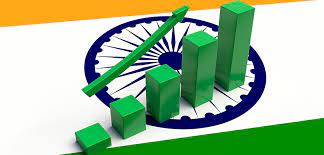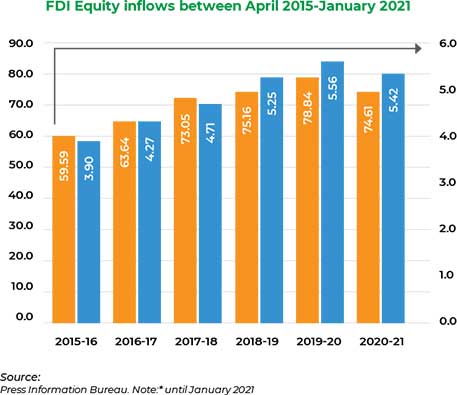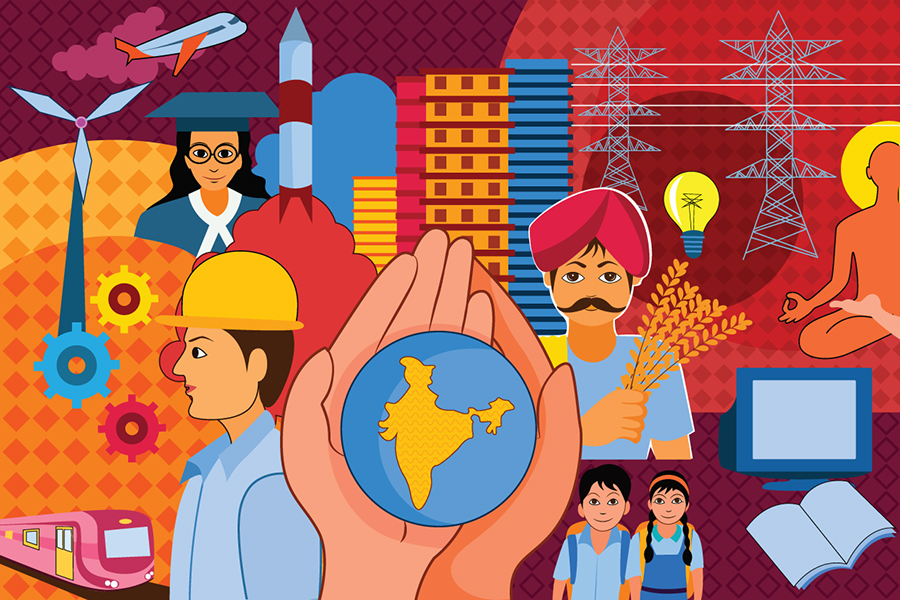Bloom vs Gloom: When it comes to the economy, the evidence warrants agnosticism.

Overestimation of domestic demand and economy has always been a problem. This has been exacerbated by unequal income distribution.
Current views on the Indian economy’s prospects appear to oscillate between alarmism and triumphalism. For example, you can contrast Morgan Stanley’s recent exuberant report on India’s impending economic boom with CMIE analysis on India’s dismal employment record and also the enduring constraint it poses. A lot of economic debate is influenced by political mood. There are genuine difficulties in determining what is going on.
In some cases, there isn’t enough data, exacerbated by the government’s aversion to information. Various shocks have taught us how much of our economic knowledge is post facto. Growth is frequently the result of specific conjunctures. Changing circumstances can compensate for what appears to be a structural impediment to growth at one point. However, it is worthwhile to consider the optimists’ case. Why is India more competitive and appealing now? Will any of these circumstances occur?
The story of the optimist revolves around India’s vastly improved infrastructure. While not world-class, India’s logistics are improving. Surprisingly, Morgan Stanley claims that land is not a legally binding constraint. India’s digital infrastructure has the potential to be exceptional. Optimism is well-founded here. However, the Morgan Stanley report makes two additional claims. The first is that digital infrastructure will lead to service offshoring to India, and the second is that it will lead to increased access to credit, enabling growth. Both of these are plausible claims, but they are far from certain.
India’s energy transition is the second pitch. Historically, India’s economic performance has been linked to the price of oil. Optimists predict a significant green energy transition that will attract more investment and make India’s energy self-sufficient and competitive. This falls into the plausible but difficult category. This story contains a big “if.”
The third factor is a resurgence of manufacturing optimism. Production-linked incentive schemes can work on the margins. The baby steps in defence manufacturing, such as Apple’s investments, could reach a critical mass, allowing us to create an ecosystem with massive spillover effects. Pessimists dismiss this possibility too quickly. This is now a great plausible story, but whether it will come to fruition remains to be seen.
Human capital is the fourth component. India has a long road ahead of it. However, many human capital quality assessments are post facto; we infer main human capital qualities from successful economies. However, India has enough human capital to make this a non-binding constraint.
Domestic demand is the fifth component. This has been the case of the optimist’s Achilles heel. Overestimation of domestic demand has always been a problem. This has been exacerbated by unequal income distribution. The NREGA and PDS have helped to soften the blow for the poor.
However, you cannot sustain consumption on the current backs of only the top 10%; most post-Covid consumption trends indicate increased demand, mainly due to the wealthy. According to the Morgan Stanley report, the percentage of households earning Rs 10,000-30,000 will rise from 24% to 46% over the next eight years. Pessimists would say the following.
India’s growth is capital-intensive. As a result, income distribution may become even more skewed. Agriculture growth aided the previous consumption boom. Can that happen again, especially in light of climate change? It’s worth considering whether increased public employment will help to change this distribution. For the time being, however, projections of India’s consumption distribution appear speculative at best.
The sixth component is MSMEs and the informal sector, which have taken significant hits in recent years. The assumption has always been that small businesses are sufficiently linked to supply chains, allowing growth at the top to pull them up. This assumption could still be correct. But can we be confident that these connections will continue to exist?
The seventh factor is geopolitical. This is the belief that India will benefit from the need to diversify away from China. This is the least credible of the optimists’ claims. It is still being determined whether more than a small portion of China’s offshoring will go to India rather than Vietnam or Indonesia. For another thing, the extent of offshoring is most likely exaggerated. FDI into China is still increasing; unless a war breaks out, there may not be a significant shift. Geopolitics as a growth strategy is unsustainable.

Morgan Stanley glosses over the eighth element, the state. In many ways, state capacity has steadily increased over the last two decades. India’s macroeconomic regime, like its foreign policy, is characterized by cautious prudence. The outlook for state revenues is upbeat. The quality of state spending has improved as well. However, four clouds remain in the sky.
The first is government finances. Public investment has fueled much of India’s recent growth. However, given the pressures of subsidies, expanding public employment, and a return to the old pension scheme, public investment may face more severe constraints.
Second, the regulatory framework remains in flux. The implications of building swadeshi in the e-commerce space may be alright, but our fundamental outlook on trade is still being determined. Third, there are the usual challenges of being unable to deal with complex governance issues, such as pollution and urbanization, which have reputational consequences.
Finally, the uncertainties result from allowing a couple of national champions to dominate the economy across so many sectors. What are the systemic risks this poses to competitors and also the financial system as a whole? However, you can still argue that the Indian state has enough credibility to attract investment.
But here’s the catch. If you can’t persuade investors, the analytics will only matter a little. According to the optimists, private investment in India still lacks the momentum that would be expected. Is this due to structural, transitional, or psychological factors? Possibly, the euphoria of Morgan Stanley’s reports has yet to be matched by investors, including its own. However, the truth may be that the evidence warrants agnosticism rather than hyped up bloom or catastrophic gloom when it comes to the economy.
A reassessment of the economic outlook is required for the government to tweak the policy framework to maintain macroeconomic stability-
This reassessment of vital economic variables may imply an acknowledgement that, while India will be one of the main fastest growing economies also during this period, it will not be immune to changing global conditions. The revised forecasts indicate that the economy will grow at a slower pace than previously anticipated.
With growing uncertainty about the global economy’s future, policymakers in Delhi appear to be rethinking the country’s macroeconomic outlook. This reassessment of key economic variables may imply an acknowledgement that, while India will be also one of the current fastest growing main economies during this period, it will not be immune to changing global conditions.
According to the revised expectations reported in this paper, the economy is likely to grow slower than previously expected, even though the combination of high inflation and also high fiscal and current account deficits may increase economic vulnerability.
The Reserve Bank of India forecasted 7% growth in 2022-23 in its most recent monetary policy committee meeting, slightly lower than its previous forecast of 7.25%. However, government officials now believe that growth of around 6.5 percent will be “reasonable.”
While more clarity on economic conditions will emerge after the release of second-quarter GDP figures at the end of this month, this reassessment may reflect a more realistic assessment of the economic outlook in light of global and domestic macroeconomic conditions. The impact of aggressive central bank tightening in developed economies is already being seen in India’s export data.
The inflation and twin deficit assessments are both cause for concern. In terms of inflation, government officials expect retail inflation to be 6.5 percent at the main end of the fiscal year. In comparison, the RBI predicts that inflation will fall from 6.5 percent in the third quarter to 5.8 percent in the fourth. Inflation fell to 6.77 percent in October, down from 7.41 percent in September, according to data released on Monday.
Despite the decrease, inflation will remain above the central bank’s target. Despite significantly higher than budgeted food and fertilizer subsidies, government officials hope to keep the fiscal deficit at 6.5 percent of GDP. Higher-than-expected tax receipts will help bridge a portion of the gap. The Centre’s tax collections increased by around 18% in the main first half of the year and compared to less than 1.8% projected in the Union budget.

While the government is likely to keep non-productive spending under control, rising crude oil prices will also continue to weigh on the current account deficit. Given the likelihood that these risks will not abate in the near term, the policy framework should be geared toward preserving macroeconomic stability. However, doing so necessitates first a main realistic assessment of the state of the economy.
An insider’s look at India’s economy-
This book chronicles C Rangarajan’s thoughts and actions on a variety of issues from 1982 (when he left academia to join the RBI) to 2014.
C Rangarajan served as Governor of the current Reserve Bank of India from 1992 to 1997, arguably one of the most difficult periods in the central bank’s history. Rangarajan who is a professional economist with a certificate of PhD from the University of Pennsylvania and has also served as chairman of the Twelfth Finance Commission and also chairman of the Prime Minister’s Economic Advisory Council, member of the former Planning Commission, Governor of Andhra Pradesh, and Rajya Sabha member, as well as chairing several influential committees.
His entire adult hood has been spent contributing to and witnessing the economic growth of independent India up close. This book chronicles his thoughts and actions on a variety of issues from 1982 (when he left academia to join the RBI) to 2014.
The first sequence of the book’s three parts, which covers the Rangarajan’s time at the RBI from 1982 to 1991, describes the origins of the balance of payments crisis in minute detail. The second section, about his time as RBI Governor, describes how the RBI adapted to the fundamentally altered paradigm of the Indian economy in the aftermath of the 1991 economic reforms. Rangarajan discusses his time at Raj Bhavan and the Finance Commission in Part 3.
While this is an especially valuable book for students of Indian economic history, general readers will likely find the final two chapters — “Advice to government” (his stint as Manmohan Singh’s PMEAC chairman) and “Some ruminations” — of particular interest. In these chapters, Rangarajan discusses recent economic developments, such as the post-2011 slowdown, as well as the significant challenges and opportunities that India faces.

In reference to the 2016-17 economic slowdown, he says, “The shocking management failure with respect to demonetization…and the ongoing teething problems of GST had their adverse impact on the economy.” The data clearly show that the investment has deteriorated.”
He emphasizes that reforms cannot be pushed “under the shadow of a crisis” (as they were in 1991), and that “more discussion and consensus building” is required in all sectors. He warns that “Atmanirbhar should not result in pure import substitution…an open economy with some limitations is still the best route to follow,” citing the experience of the first decades after independence.
edited and proofread by nikita sharma




